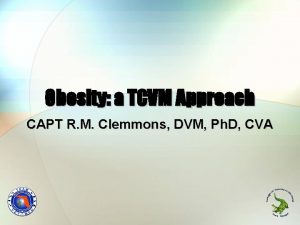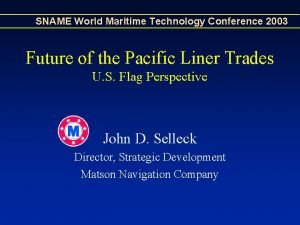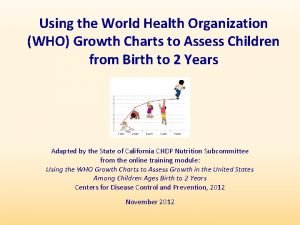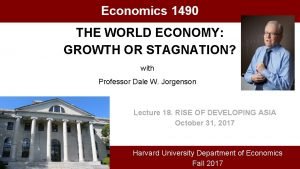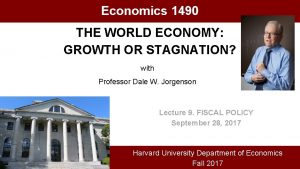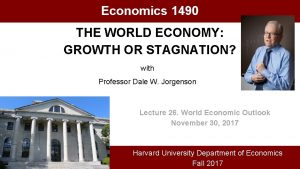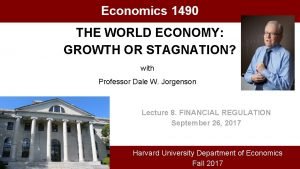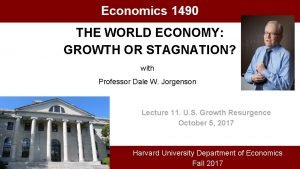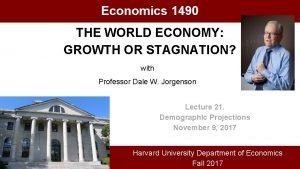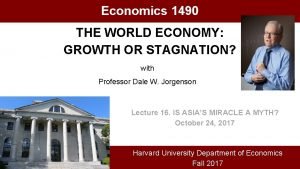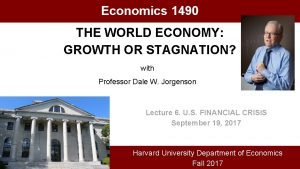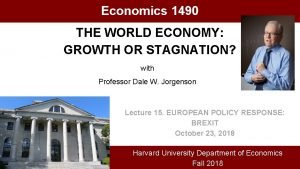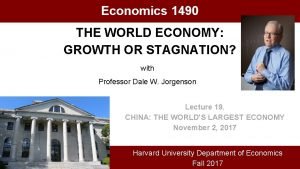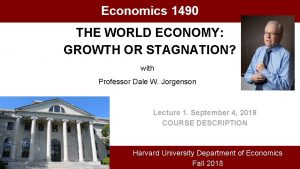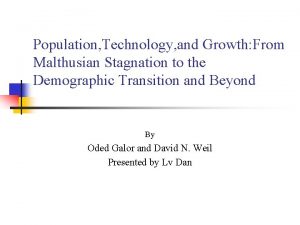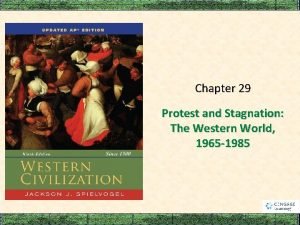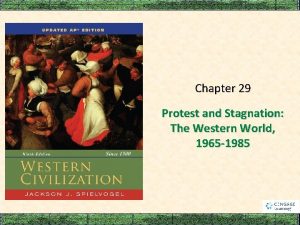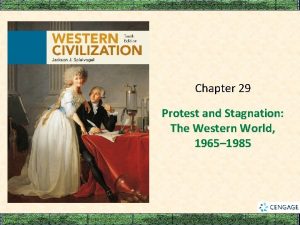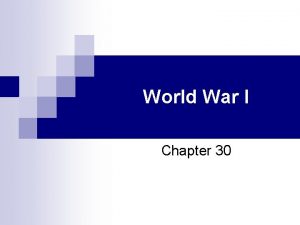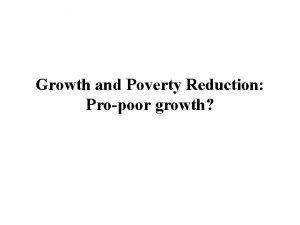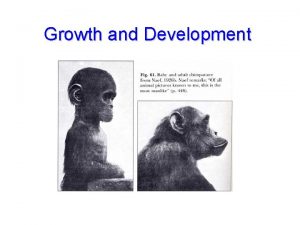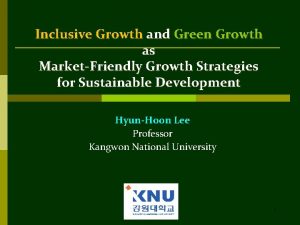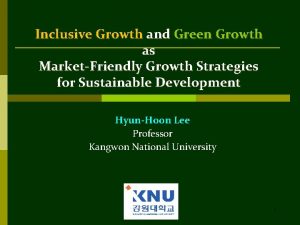Conference on Growth and Stagnation in the World















































- Slides: 47

Conference on Growth and Stagnation in the World Economy, The Third World KLEMS Conference, Tokyo, Japan, May 19 -20, 2014 Estimation of Land Inventory Stocks by Industries as Capital Inputs in Korea* Hak K. Pyo and Keun Hee Rhee** *An earlier version of this paper was presented at Seminar on Estimation of Land Inventory Stocks for Asia KLEMS Database, Statistics Directorate, OECD, Paris, November 21, 2013 and at Meeting on Harmonization of Japan Industrial Database with Asia KLEMS Database on January 11, 2013, and at Meeting on Estimation of Land Inventory Stocks for Asia KLEMS Database on April 25, 2013 at RIETI in Tokyo, Japan ** Visiting Scholar, Korea Institute for International Economic Policy and Professor Emeritus, Seoul National University and Senior Fellow, Korea Productivity Center respectively. All correspondences should be addressed to pyohk@plaza. snu. ac. kr

Outlines 1. Introduction 2. Estimation of Land by Industries 3. Estimation of Inventory Stocks 3. 1 Harberger’s Method 3. 2 The Acceleration Model 3. 3 A Modified Benchmark-Year Estimation Method 4. Conclusion 2

1. Introduction • • • Mamalakis(1992): Broadening the coverage of capital stock may entail too many imputations and measurement error. Land is not produced means of production. Goldsmith (1975): Land is the most difficult component of national wealth to estimate. Nomura (2004): Inventory stocks should be defined as a capital because it is a means-of-production and used over one year accounting period. But it is not a durable good and has no depreciation and therefore, cannot be estimated by PIM (Perpetual Inventory Method) There have been two groups: (1) Exclusion of Land Inventory Stocks: BEA (1993), EU KLEMS (2007) and National wealth Survey (1968, 1977, 1987, and 1997) in Korea (2) Inclusion of Land Inventory Stocks: Goldsmith (1975) Kendrick (1976), Jorgenson, Gollop and Fraumeni (1987) and OECD (2009) 3

Inclusion of Land Inventory Stocks: Important for Asia KLEMS • Land is an important part of productive stock which generates capital services to production activities • The significant portion of national income accrued to capital is rents to land of owner-occupied residential structure and tenant- occupied residential and non-residential structure. • The economies with a large agricultural sector such as Asia KLEMS member countries need to include land inventory stocks to impute capital services and rates of return without too much bias (EU KLEMS, 2007, p. 34) 4

Inclusion of Land Inventory Stocks: Important for Asia KLEMS • Jorgenson, Gollop and Fraumeni (1987): (1) producers’ durable equipment (2) Consumers’ durable equipment (3) Tenant-occupied residential or non-residential structure (4) Owner-occupied residential structure (5) Inventory (6) Land • OECD defines four types of land: (1) Natural land under buildings and structures and associated surface water (2) Natural land under cultivation and associated surface water (3) Natural recreational land associated surface water (4) Other natural land associated surface water 5

Inclusion of Land Inventory Stocks: Important for Asia KLEMS • 1993 SNA defines four categories of inventory stocks: (1) Materials and Supplies (2) Finished Goods (3) Goods purchased for resale and (4) Work-in-progress. • It should be noted that National Wealth Survey in Korea includes all three categories except Construction-in-progress which is a part of Work-in-progress. • National Wealth Survey treats Construction-in-progress as a part of fixed tangible assets. • It also includes Construction-in-progress not all of Work-in-progress in the fixed tangible assets because 93 definition of Work-in-progress is so wide that some other types of Work-in-progress may not be regarded as capital inputs. 6

Inclusion of Land Inventory Stocks: Important for Asia KLEMS Value of Land • 2008 SNA (Paragraph 13. 44) states: In principle, the value of land to be shown under natural resources in the balance sheet is the value of land excluding the value of improvements, which is shown separately under fixed assets, and excluding the value of building on the land which is also to be shown separately under fixed assets. • Land is valued at its current price paid by a new owner excluding the costs of ownership transfer which are treated by convention, as gross fixed capital formation and part of land improvements and are subject to consumption of fixed capital. In terms of inventory stocks, we need to decide whether we should include all of Work-in-progress in the inventory stocks. 7

Developing Asia has undergone significant transformation <Figure 1> Employment and Output Shares, Developing Asia: Compare 1975 with 2010 Source: Brooks(2013), “Asia’s Economic transformation: Where to, How, and How Fast? ”, The Second Asia KLEMS conference 8

but agriculture is still a larger employer than in other regions <Figure 2> Employment and Output Shares, Developing Asia: 2010 or latest Source: Brooks(2013), “Asia’s Economic transformation: Where to, How, and How Fast? ”, The Second Asia KLEMS conference 9

2. Estimation of Land by Industries Based on Pyo(1992) 10

2. Estimation of Land by Industries • As noted in Pyo (1992), the Study Report by the Committee for the Public Concept of Land (here-in-after called the Land Report for simplicity) published in 1989 was the first economy-wide benchmark estimates of land. • The report contains estimates of land by types of land as of January 1 of 1985. According to the report, the share of agricultural land (paddy field, ordinary fields and forest land) and that of non-agricultural land (land for buildings and structures, plant sites and others) in value was 32. 8 percent and 67. 2 percent respectively. • However, there is no information on industrial composition of non-agricultural land. At Mining and Manufacturing level, there have been Mining and Manufacturing Census and Reports which includes the value of land in manufacturing establishments at the beginning of year, value increase and decrease during the year and at the end of year. 11

2. Estimation of Land by Industries • Another potential source of estimates of land is Financial Statement Analysis published by the Bank of Korea but it only covers listed firms’ data in selected industries. • Economic Census in 2010 by the Statistics Korea was conducted on all establishments engaged in industrial activities to provide products or services at or within one geographic area, such as a factory, a shop, a mine, a business office, a branch office or a head office. 12

2. Estimation of Land by Industries Ø Estimates of Land(1954 -1990) • We have found the fact that the data on land are typically available by the zoning area not by industries. But fortunately we found that Establishment Census in 1987 reported the size (not value) of land by industries. • In order to make use of Establishment Census, we have taken following steps to estimate value of land by industries: 13

2. Estimation of Land by Industries Ø Estimates of Land(1954 -1990)(cont. ) 1) We deflated the 1985 value estimate of land by the average land price index for the entire nation to convert the estimate into constant price series. Since the index is available only after 1985, we had to backcast the index by regressing it on the Metropolitan Land Price Index which is available since 1964. Then, the backcasted index during 1964 -1974 and the observed index during 1985 -1989 are regressed on the index of GNP deflator to backcast further for the period of 1953 -1963. The combined series of the average land price index has been used to deflate the 1985 value estimate of land. 2) Even in real terms, it is difficult to assume that the value of land remained constant over 25 years between 1953 and 1989. Therefore, for the period of 1953 -1984, we subtracted the amount of land improvement and orchard development in 1985 constant prices which appear in national income accounts from the 1985 value estimate of land. 14

2. Estimation of Land by Industries Ø Estimates of Land(1954 -1990)(cont. ) 3) Additional adjustment has been made to account for the change in agricultural land. According to the Land Report (1989), the total area of agricultural land has increased from 1, 970 thousand ha in 1950 to 2, 144 thousand hectare in 1985 for 2, 000 farm households. Therefore, for the period of 1953 -1984, we calculated the proportional area of agricultural land increase in value and subtracted it from the estimate of the agricultural land. The difference was allocated to the nonagricultural land. 4) We allocated the value estimate of paddy fields, ordinary fields and forest land to Agriculture, Forestry & fishing. The land for buildings and structures needs to be decomposed into residential land nonresidential land before being allocated to non-agricultural industries. We assumed that about 7. 2 percent (205. 7 km 2) of the total unincorporated private land (2, 847. 4 km 2) for buildings and structures belong to the unincorporated business. 15

2. Estimation of Land by Industries Ø Estimates of Land(1954 -1990)(cont. ) 5) We also allocated the value estimate of the plant site to the Manufacturing and Electricity, Gas & Water industry only. 6) Finally, the sum of 7. 2 percent of the unincorporated private nonresidential land other types of land is allocated to all industries using the weights of land space by industries in 1986 Establishment Census. 7) The resulting estimates of land are compared with estimates of other wealth components which are more readily available in current prices. The share of land in Gross National Wealth was estimated to be 32. 2 % in 1954 but increased to 44. 7 % level in 1968 and then declined to reach 34. 3 % in 1990. 16

2. Estimation of Land by Industries Ø Estimates of Land(1954 -1990)(cont. ) <Table 1> Summary Estimates of National Wealth of Korea(1953 -1990) Unit: Billion Won, Current prices, (%) 1954 1962 1968 1977 1987 1990 Reproducible Fixed Assets 473 (65. 59) 1715. 7 (61. 97) 4748. 6 (48. 52) 45236. 7 (43. 25) 386894. 2 (53. 09) 645926. 7 (48. 00) Nonresidential Fixed Assets 296 (41. 04) 1074. 1 (38. 8) 2932. 3 (29. 96) 32374. 5 (30. 95) 305950. 6 (41. 98) 498670. 1 (37. 06) Inventory stocks 14. 9 (2. 07) 94. 9 (3. 43) 472. 6 (4. 83) 6999. 5 (6. 69) 54928. 6 (7. 54) 79118. 0 (5. 88) Land 232. 3 (32. 21) 932. 4 (33. 68) 4376 (44. 71) 41858. 7 (40. 02) 210955. 4 (27. 71) 461370. 0 (34. 29) 1 (0. 00139) 25. 5 (0. 92) 189. 9 (1. 94) 10507. 5 (10. 05) 85006. 7 (11. 66) 159152. 7 (11. 83) 721. 2 (100) 2768. 5 (100) 9787. 1 (100) 104602. 4 (100) 728784. 9 (100) 1345567. 4 (100) Net Foreign Liabilities 1. 4 11. 6 175. 2 4152. 3 21236. 3 9291. 80 Gross National Wealth (GNW) 719. 8 2756. 9 9611. 9 100450. 1 707548. 6 1336275. 6 GNP 66. 2 355. 5 1652. 9 17806. 6 106024. 4 166437. 8 GNW/GNP Ratio 10. 9 7. 8 5. 6 6. 7 8. 0 Consumer Durables Gross Domestic Wealth Source: Pyo(1992), Table 1 17

2. Estimation of Land by Industries Ø Estimates of Land(1954 -1990)(cont. ) • Goldsmith (1975) used the value land/structure ratio to estimate the value of nonagricultural land in his study. Starting from the estimate (0. 39) for 1904 of Japan by Igarashi and Takahashi, he assumes that it had risen over time and reached in the neighborhood of unity in 1970. • However, as he admitted the method of applying the land/structure ratio to estimate the value of land is quite questionable due to the divergence between the book-value ratio and the market-value ratio and the lack of a comprehensive survey on both land structures. • According to Goldsmith (1975), the urban land price index in Japan has risen almost 4, 600 times between 1936 and 1970 while the urban area has expanded by a little over one-third. According to Pyo (1992), the land price index in Korea has risen 2, 310 times between 1953 and 1990. 18

2. Estimation of Land by Industries Ø Estimates of Land after 1990 • A synthetic estimation of land after 1990 can be made by making use of National Wealth Survey published by Statistics Korea for the period of 1997 -2010. • Statistics Korea had conducted the fourth since 1968 and the last national wealth survey in 1997 but it included fixed reproducible tangible assets, inventory stocks and consumer durable and semi-durable goods not land. • Therefore, there are two alternative methods to make a synthetic estimation of land after 1990. One is to extend the series of 1953 -1990 by making use of some flow data (1970 -1998) such as land improvement and orchard improvement in Table 4 to the stock of 1990. The imputed deflator for land improvement increased by 22. 1 times between 1970 and 1998. 19

2. Estimation of Land by Industries Ø Estimates of Land after 1990(cont. ) • However, the Bank of Korea no longer publishes the data after 1998. • We can make use of Mining and Manufacturing Reports which includes the value of land at the beginning of establishments, increase and decrease of the value during the year and the value of land at the end of the year as summarized in Table 5 of the paper. • These are book values reported by establishments. The data in 2010 seems from Economic Census conducted in 2010 which reports from firm-level survey not establishment survey and therefore, cannot be relayed to the series before 2010. 20

2. Estimation of Land by Industries Ø Estimates of Land after 1990(cont. ) • Another alternative source of estimates of land is Balance Sheet data in Financial Statement Analysis compiled by the Bank of Korea as summarized in Table 6 of the paper. • The data covers only listed firms in selected industries and therefore cannot be regarded as economy-wide estimates of land by business establishments. • For the period of 2008 -2011, the value of land occupied about 18 % of total value of non-current assets. 21

2. Estimation of Land by Industries Ø Estimates of Land after 1990(cont. ) <Table 2> Value of Land on Balance Sheet (%) Unit: Billion Won, Current prices, 2007 2008 2009 2010 2011 1, 003, 355 (100) 1, 310, 372 (100) 1, 669, 578 (100) 1, 828, 236 (100) 2, 005, 625 (100) (1) Investments 316, 383 345, 044 415, 195 477, 412 586, 560 (2) Tangible assets 607, 578 800, 470 1, 060, 386 1, 142, 032 1, 174, 468 (2 a) land 146, 873 (14. 64) 228, 783 (17. 46) 301, 772 (18. 07) 325, 989 (17. 83) 342, 475 (17. 08) (2 b) Building and structures 187, 784 221, 458 267, 636 281, 862 303, 964 (2 c) Machinery and equipment 156, 972 178, 796 189, 730 204, 546 250, 414 (2 d) Ship, vehicles and transportation equipment 30, 193 47, 214 40, 786 50, 090 41, 731 (2 e) Other plant assets 33, 805 47, 613 115, 681 125, 750 123, 140 (2 f) Construction in progress 45, 534 72, 713 144, 783 153, 795 112, 745 (2 g) Other tangible assets 6, 418 3, 922 0 0 0 (3) Intangible assets 32, 537 74, 586 97, 301 111, 147 137, 163 (4) Other non-current asset 46, 858 90, 273 96, 695 97, 646 107, 433 Non-current Asset Source: The Bank of Korea, Financial Statement Analysis, 2011 22

2. Estimation of Land by Industries Ø Estimates of Land after 1990(cont. ) • For the period of 1980 -2011, the estimates of fixed reproducible tangible assets are available from Pyo (2012) as shown in Tables 7 -10 of the paper. • The estimates of residential buildings and nonresidential buildings and structure can be used to impute the value of land on which they were built. • A preliminary report by the Bank of Korea (2012) suggests to apply 40 % to impute land value of all nonresidential buildings and structures, 65 % to impute land value of all residential buildings and about 50 % to impute land value of all Agricultural land, Forest land public and other land from National Wealth estimates of Statistics Korea. 23

2. Estimation of Land by Industries Ø Estimates of Land after 1990(cont. ) • The report estimates the economy-wide value of land as of the end of 2010 as 5, 300 trillion Won at market prices which is greater than the sum of land value (3, 536 trillion Won) evaluated at the public-notice prices announced by the Ministry of Land, Transport and Maritime Affairs and estimate of land (3, 568 trillion Won) in National Wealth compiled by Statistics Korea (2011) which occupies 69. 2 % of all national wealth total (7, 778. 6 trillion Won) as summarized in Table 11 of the paper. • Therefore, the valuation of land makes a great difference among estimates depending on what price index of land are used. On the other hand, Statistics Korea’s Economic Census (2010) reports Land (274 trillion Won), Building (185 trillion Won) and Structure (60 trillion Won) as of the end of 2010 from the 254, 373 total number of enterprises being surveyed. 24

2. Estimation of Land by Industries Ø Estimates of Land after 1990(cont. ) • Therefore, even after applying 50 % valuation of land for Building and Structure, we still end up with an estimate of total land of 396. 5 trillion Won which is only 11. 1 % of their own estimate of land (3, 568 trillion Won) on National Wealth. • This illustrates how little can be covered from establishment surveys as far as estimation of land is concerned because residential land, agricultural land other public-use land are not included in the establishment surveys. 25

2. Estimation of Land by Industries Ø Estimates of Land after 1990(cont. ) <Table 3> National Wealth by Types of Assets As of end of 2010 Total Assets Tangible Intangible Fixed (preliminaries) Amount Fixed Assets 7, 778. 6 3, 380. 3 (100) 344. 1 Public asset Variation Unit: Trillion Won, (%) Standing Underground Durable Timber Resources Consumer Goods 3568. 4 34. 2 57. 8 204. 9 (6. 3) (45. 9) (0. 4) (0. 7) (2. 6) 35. 5 110. 3 7. 4 9. 9 12. 1 Inventory Land 43. 3 489. 7 (43. 5) (0. 6) 168. 1 0. 8 Source: Statistic Korea (2011) 26

2. Estimation of Land by Industries Ø Estimates of Land after 1990(cont. ) -------------------------------------------1. Bank of Korea (2012) (Residential building, 65%), (Nonresidential building and structure, 40%) 5, 300 2. Ministry of Land, Transport and Maritime Affairs (2011) 3, 536 3. Statistics Korea, National Wealth (2011) Tangible Fixed Assets Land Imputed Total Land 3, 380 3, 568 5, 258 (1, 690) 27

4. Statistics Korea , Economic Census(2012) 5. Pyo and Rhee(2012) (All industries) Building 185 Structure 60 Land (93) (30) (Manufacturing) Building 58 Structure 9 Land (29) (4) 123 274 397(100%) 33 86 119(30. 0%) Residential Building Non residential building Structure 3, 089 3, 536 878 957 1, 254 (1, 545) 28

6. Pyo and Rhee (2013) based on land tax records - Taxable Land - Land subject to non-taxation, reduction and exemption - Taxable Structures and Houses - Structures and Houses subject to non-taxation, reduction and exemption 1, 151. 3 706. 0 1. 857. 3 (a) 1, 564. 3 154. 5 1, 718. 8 (b) - Land/Structure Ratio: (a)/(b)=1. 85/1. 72 --------------------------------------- 29

2. Estimation of Land by Industries Ø Annual Report of Local Tax Administration • As shown in Table 4, total tax base of land in Korea which was subject to the land property tax in Korea in 2011 is estimated to be a total of 1, 857. 3 trillion Won with 1, 151. 3 trillion Won of taxable land 706. 0 trillion Won of land subject to nontaxation, reduction and exemption. • On the other hand, total tax base of Buildings and Structures and Houses in Korea in 2011 is estimated to be a total of 2, 012. 0 trillion Won (1, 857. 3 trillion Won of Buildings and Structures and 154. 7 trillion Won of Houses) with a total of 1, 564. 3 trillion Won of Taxable Buildings and Structures and Houses (335. 9 trillion Won of Buildings and Structures and 1, 228. 4 trillion Won of Houses) and a total of 154. 7 trillion Won of Buildings and Structures and Houses subject to non-taxation, reduction and exemption (104. 5 trillion Won of Buildings and Structures and 50. 2 trillion Won of Houses). • Therefore, the overall Land/Structure ratio in valuation in Korea in 2011 is estimated to be around 1. 8/2. 0 which is close to 1. 0 quoted in Goldsmith (1975) from Igarashi and Takahshi’s study on Japan’s estimate of Land/ Structures. ) 30

2. Estimation of Land by Industries Ø Estimates of Land after 1990(cont. ) <Figure 3> Comparative Estimates of Land (2010) 6000 5300 Unit: Trillion Won, (%) 5258 5000 4000 3596 3536 3000 2000 1000 0 397 Bank of Korea(2012) Ministry of Land, Statistic Korea, Pyo and Rhee(2012) Trandport and National Wealth (2011) Economic Census(2012) Maritime Affairs (2011) Source: Bank of Korea(2012), Ministry of Land, Transportation and Maritime Affairs(2011), Statistic Korea, National Wealth(2011), Statistic Korea, Economic Census(2012), Pyo and Rhee(2012) 31

3. Estimation of Inventory Stocks 32

3. Estimation of Inventory Stocks Ø Harberger’s Method (1) I = Three-year moving average of investment during three normal years δ = Depreciation rate - Building(2. 5%), - Machinery and Equipment(8%) - Inventory stocks(0%) 33

3. Estimation of Inventory Stocks <Assumption> There will not be great deal of errors in estimating inventory stocks by using the ratio of inventory investment to GNP <Example> The ratio of accumulated inventory investments to accumulated incremental GNP is multiplied by 1955 GNP to estimate 1955 inventory stocks 34

3. Estimation of Inventory Stocks • 35


3. Estimation of Inventory Stocks Pyo(2005) (1986 -2004) (7) (1971 -1997) (8) (1971 -2012) (9) This study(2013) 37

3. Estimation of Inventory Stocks Modified Benchmark-Year Estimation As noted by Harberger (1978), there is an intrinsic difficulty in estimating inventory stocks in the sense that it is not reproducible tangible asset and therefore, it has no depreciation. The zero depreciation property and the negative values of inventory investment in certain years make it difficult to apply perpetual inventory method (PIM) to generate inventory stocks. For example, according to Pyo (2005), when the 1987 NWS estimate of inventory stocks was used as the initial value and the inventory investment data on national accounts were kept being added to it cumulatively without applying any depreciation, the generated 1997 estimate of inventory stocks (70, 087 billion Won) was only 27. 2 percent of the actual survey estimate (257, 534 billion Won) by 1997 NWS. Therefore, a pure PIM or a modified PIM which makes use of at least one benchmark estimate seems to break down. 38

As an alternative model of modified PIM, Pyo (1992) applied the following method. First, the ratio of inventory stock was defined as follows: Inventory-output Ratio = Inventory Stocks in current prices in a benchmark year / Gross output in current prices in preceding year <Assumption> The current level of inventory stocks is mostly affected by the gross output in the preceding year since firms adjust their level of inventory to the level of output in the preceding year not the level of value added because investment includes intermediate inputs and work-in-progress. 39

In addition the inventory stocks are concentrated in a few industries. For example, the 1997 NWS has the distribution of inventory stocks by industries: Manufacturing (48 %), Retail and Wholesale Trade (25 %), Construction (14 %) and Agriculture Fishery and Forestry (7 %) and all other industries (6 %). Therefore, the inventory-output ratio can be computed for selected industries using inventory stock data from benchmark-year estimates and gross output data from national accounts or Input-Output Tables. 40

<Table 5> Inventory Stock-Gross output Ratio and Inventory Stock-GDP Ratio in Korea Billion Won, current price, (%) 1967 Gross Output GDP 1, 7991) 1, 259 1968 1, 630 1976 32, 015 14, 305 1977 40, 020 18, 356 1986 222, 569 98, 110 1987 264, 094 115, 164 1996 940, 117 448, 596 1997 1, 030, 304 491, 135 Rate of Inventory/ Gross output Inventory/ GDP 357 0. 198166 0. 283 5, 985 0. 186954 0. 418 52, 135 0. 234240 0. 531 257, 534 0. 273938 0. 574 Note : 1) The data of nominal gross output in 1967 is estimated from National Accounts in 1984 2) The rate of Inventory=INVt/Gross outputt-1(or GDPt-1), where t is a benchmark year Sources: Pyo(2005) Table 11 and Table 13 41

<Figure 4> Estimation of Total Inventory Stock Billion Won, current price Estimation by INV-Output Ratio Estimation by INV-GDP Ratio 450 000 400 000 350 000 300 000 250 000 200 000 150 000 100 000 50 000 2003 2002 2001 2000 1999 1998 1997 1996 1995 1994 1993 1992 1991 1990 1989 1988 1987 1986 1985 1984 1983 1982 1981 1980 1979 1978 1977 1976 1975 1974 1973 1972 1971 1970 1969 1968 0 Sources: Pyo(2005) 42

<Figure 5> Estimation of Industrial Inventory Stock using Inventory Stock-Gross output Ratio (1968 -2003) Billion Won, current price 200000, 0 180000, 0 160000, 0 140000, 0 120000, 0 100000, 0 80000, 0 60000, 0 40000, 0 20000, 0 Agriculture, Forestry & Fishing Mining & Quarrying Manufacturing Electricity, Gas & Water Construction Wholesale and Retail Trade Transport, Stirage & Communication Financing, Insurance, Real Estate & Business Services 2003 2002 2001 2000 1999 1998 1997 1996 1995 1994 1993 1992 1991 1990 1989 1988 1987 1986 1985 1984 1983 1982 1981 1980 1979 1978 1977 1976 1975 1974 1973 1972 1971 1970 1969 1968 0, 0 Community Sources: Pyo(2005) 43

<Figure 6> Estimation of Industrial Inventory Stock using Inventory Stock-GDP Ratio(1968 -2003) Billion Won, current price 200000 180000 160000 140000 120000 100000 80000 60000 40000 20000 Agriculture, Forestry & Fishing Mining & Quarrying Manufacturing Electricity, Gas & Water Construction Wholesale and Retail Trade Transport, Stirage & Communication Financing, Insurance, Real Estate & Business Services 2003 2002 2001 2000 1999 1998 1997 1996 1995 1994 1993 1992 1991 1990 1989 1988 1987 1986 1985 1984 1983 1982 1981 1980 1979 1978 1977 1976 1975 1974 1973 1972 1971 1970 1969 1968 0 Community Sources: Pyo(2005) 44

<Figure 7> Comparison of Industrial Inventory Stock using Four Other Estimations Billion Won, 2005 constant price 800000 700000 600000 500000 400000 300000 200000 19 7 7 19 8 7 19 9 8 19 0 8 19 1 8 19 2 8 19 3 8 19 4 8 19 5 8 19 6 8 19 7 8 19 8 8 19 9 9 19 0 9 19 1 9 19 2 9 19 3 9 19 4 9 19 5 9 19 6 9 19 7 9 19 8 9 20 9 0 20 0 0 20 1 0 20 2 0 20 3 0 20 4 0 20 5 0 20 6 0 20 7 0 20 8 0 20 9 1 20 0 1 20 1 12 0 Series A Series B Series C Series D 45

<Table 6> Estimation of Industrial Inventory Stock using Four Other Estimations(1997 -2012) Billion Won, 2005 constant price Year Series A Series B Series C Series D 1977 40, 170 1989 162, 465 160, 723 159, 705 82, 598 2001 302, 308 389, 424 373, 670 159, 140 1978 48, 686 45, 384 46, 605 42, 720 1990 181, 036 171, 430 171, 879 88, 844 2002 306, 175 398, 725 388, 517 169, 416 1979 57, 201 51, 714 53, 266 45, 010 1991 199, 606 186, 119 189, 378 95, 976 2003 310, 399 422, 332 416, 297 173, 732 1980 65, 716 59, 204 59, 753 44, 451 1992 218, 177 205, 474 209, 439 100, 621 2004 316, 277 436, 923 427, 964 181, 045 1981 74, 232 64, 577 60, 603 46, 600 1993 236, 748 218, 500 223, 276 106, 014 2005 323, 453 473, 832 447, 732 187, 599 1982 82, 747 71, 177 67, 216 49, 186 1994 255, 319 233, 729 239, 283 113, 961 2006 333, 470 503, 224 465, 450 196, 516 1983 91, 262 78, 335 75, 092 53, 300 1995 273, 889 255, 449 262, 311 122, 761 2007 340, 672 536, 635 489, 554 205, 762 1984 99, 777 89, 277 86, 822 57, 035 1996 292, 460 285, 314 287, 958 130, 475 2008 353, 830 573, 765 514, 550 210, 137 1985 108, 293 100, 814 98, 220 60, 144 1997 311, 031 137, 110 2009 336, 729 639, 919 526, 376 210, 759 1986 116, 808 109, 869 108, 607 65, 619 1998 297, 594 329, 104 328, 967 130, 157 2010 333, 804 626, 227 528, 058 223, 106 1987 125, 323 71, 777 1999 295, 577 325, 290 310, 170 142, 469 2011 337, 123 682, 246 561, 432 230, 753 1988 143, 894 144, 528 141, 861 78, 349 2000 299, 615 355, 005 343, 454 153, 647 2012 340, 082 - - 235, 155 Note Series A: Summation of real investments, Series B: The Acceleration Model Series C: A Modified Benchmark-Year Estimation Method(Inventory-Output Ratio) Series D: A Modified Benchmark-Year Estimation Method(Inventory-GDP Ratio) 46

4. Conclusion ▪ For the difficulties in imputing the value of land or estimating inventory stocks, EU KLEMS(2007), Asia KLEMS Draft Manual(2012) have not attempted to include land inventory stocks. ▪ Because of the agrarian nature of Asia economies and rapid transition toward industrialization we have to start thinking about including imputed land inventory stocks. ▪ Otherwise we may be missing fundamental capital inputs and therefore may end up introducing too much bias in estimating rates of return and total factor productivity. 47
 Generativity vs stagnation
Generativity vs stagnation Blood stagnation treatment
Blood stagnation treatment Static pressure and dynamic pressure
Static pressure and dynamic pressure Industry vs inferiority examples
Industry vs inferiority examples Integrity erikson
Integrity erikson Industry vs inferiority
Industry vs inferiority Generativity vs stagnation
Generativity vs stagnation Maladaptation of trust vs mistrust
Maladaptation of trust vs mistrust Stagnation pondérale bébé
Stagnation pondérale bébé Relative growth rate equation
Relative growth rate equation Pith
Pith Primary growth and secondary growth in plants
Primary growth and secondary growth in plants Vascular ray
Vascular ray Carothers equation
Carothers equation Geometric growth graph
Geometric growth graph Neoclassical growth theory vs. endogenous growth theory
Neoclassical growth theory vs. endogenous growth theory Organic growth vs inorganic growth
Organic growth vs inorganic growth World cashew conference
World cashew conference Asq world conference
Asq world conference Iave world volunteer conference
Iave world volunteer conference World maritime technology conference
World maritime technology conference World health organization
World health organization Hát kết hợp bộ gõ cơ thể
Hát kết hợp bộ gõ cơ thể Slidetodoc
Slidetodoc Bổ thể
Bổ thể Tỉ lệ cơ thể trẻ em
Tỉ lệ cơ thể trẻ em Gấu đi như thế nào
Gấu đi như thế nào Tư thế worm breton là gì
Tư thế worm breton là gì Chúa yêu trần thế
Chúa yêu trần thế Môn thể thao bắt đầu bằng từ chạy
Môn thể thao bắt đầu bằng từ chạy Thế nào là hệ số cao nhất
Thế nào là hệ số cao nhất Các châu lục và đại dương trên thế giới
Các châu lục và đại dương trên thế giới Công thức tiính động năng
Công thức tiính động năng Trời xanh đây là của chúng ta thể thơ
Trời xanh đây là của chúng ta thể thơ Cách giải mật thư tọa độ
Cách giải mật thư tọa độ Phép trừ bù
Phép trừ bù Phản ứng thế ankan
Phản ứng thế ankan Các châu lục và đại dương trên thế giới
Các châu lục và đại dương trên thế giới Thơ thất ngôn tứ tuyệt đường luật
Thơ thất ngôn tứ tuyệt đường luật Quá trình desamine hóa có thể tạo ra
Quá trình desamine hóa có thể tạo ra Một số thể thơ truyền thống
Một số thể thơ truyền thống Cái miệng xinh xinh thế chỉ nói điều hay thôi
Cái miệng xinh xinh thế chỉ nói điều hay thôi Vẽ hình chiếu vuông góc của vật thể sau
Vẽ hình chiếu vuông góc của vật thể sau Thế nào là sự mỏi cơ
Thế nào là sự mỏi cơ đặc điểm cơ thể của người tối cổ
đặc điểm cơ thể của người tối cổ Thế nào là giọng cùng tên
Thế nào là giọng cùng tên Vẽ hình chiếu đứng bằng cạnh của vật thể
Vẽ hình chiếu đứng bằng cạnh của vật thể Vẽ hình chiếu vuông góc của vật thể sau
Vẽ hình chiếu vuông góc của vật thể sau

